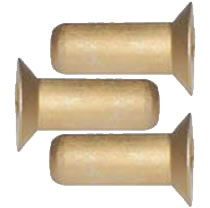
Rivets are commonly used in the aerospace manufacturing industry. The Boeing 747, for instance, features over 1 million rivets. As permanent fasteners, rivets are better protected from vibration-related loosening than traditional threaded fasteners. There are different types of rivets, however, one of which is tubular.
What Are Tubular Rivets?
Tubular rivets are mechanical fasteners consisting of a partially hollow shank and a solid head. They are used in fastening applications. To fasten two parts together, a tubular rivet can be driven into them.
You can find tubular rivets in different sizes, head configurations and materials, but they all feature a partially hollow shank.
How Tubular Rivets Differ From Solid Rivets
In addition to tubular rivets, there are solid rivets. Both tubular and solid rivets feature a similar design consisting of a cylindrical shank that’s connected to a head. The difference is that tubular rivets are partially hollow, whereas solid rivets are completely solid.
Tubular Rivet Installation
Tubular rivets are installed in precut holes. You can place a tubular rivet through a set of parts, at which point you can expand the shank.
Most tubular rivets require a tool to install. These tools will force the shank to expand, thus wrapping around the back of the parts.
Benefits of Tubular Rivets
With their partially hollow shank, tubular rivets offer several advantages. For starters, they are easier to install than their solid counterparts. As previously mentioned, installation requires the deformation of the tail (the end of the shank). Tubular rivets feature a partially hollow shank that mushrooms outward upon impact. This makes tubular rivets easier to install than solid rivets.
Another advantage of tubular rivets is the cost. Because they have a partially hollow shank, they typically cost less than solid rivets. Solid rivets contain more material in their shank, resulting in a higher production cost.
You don’t have to worry about tubular rivets loosening or coming out of the parts with which they are used. Like all rivets, they are classified as permanent fasteners. After installing a tubular rivet, it will continue to secure and hold the respective parts together. Even if the tubular rivet is exposed to vibrations, it shouldn’t loosen or come out.
In Conclusion
Tubular rivets are characterized by a partially hollow shank. They look like ordinary solid rivets. If you inspect the shank, though, you’ll notice that it’s partially hollow. This partially hollow design makes them easier to install.



